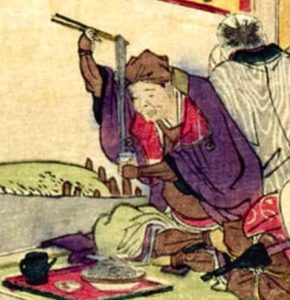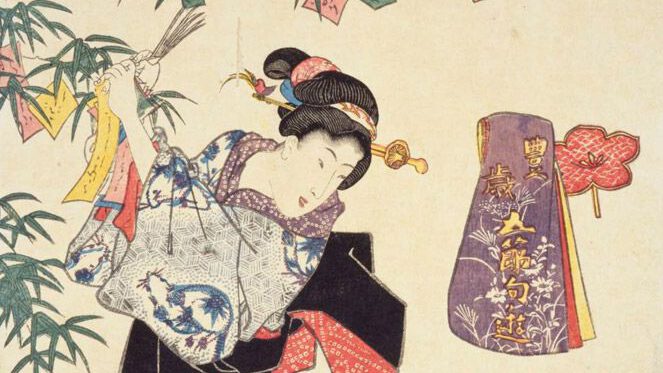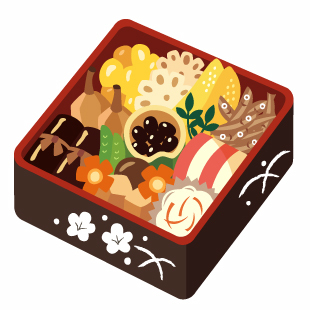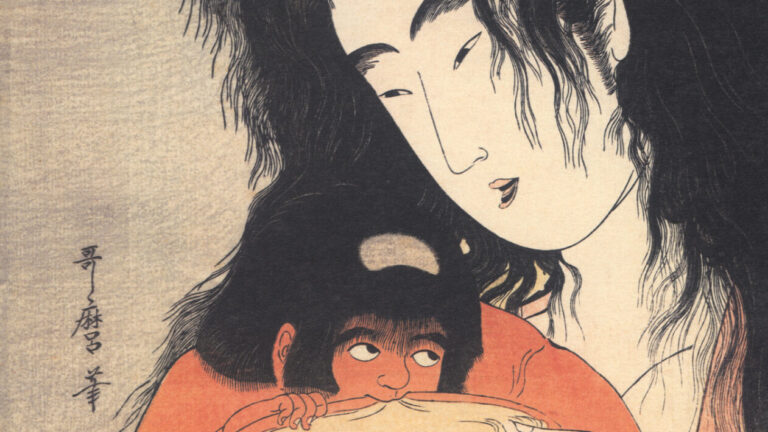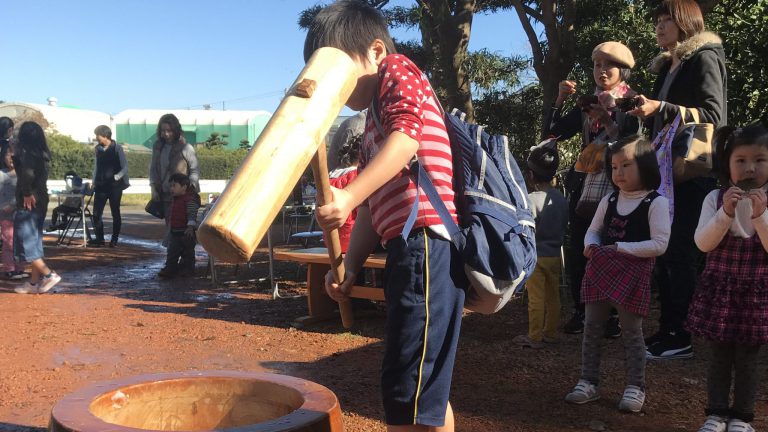Toshikoshi soba is the Japanese tradition of eating soba noodles on New Year’s Eve. It’s a custom that has continued since the 1700s. There are quite a few reasons why. Some have to do with long life, wealth, and breaking off all the hardships from the previous year.
On this episode of Uncanny Japan I’ll talk about the history, the different names it goes by, and how you, too, can participate is this delicious tradition.
Are you hungry? How about if I bring over a wooden serving tray and set it down in front of you? The first thing you notice is the cold soba noodles piled high and a shiny black lacquer plate. On top is a sprinkle of finely cut, crisp nori seaweed.
The next thing to get your attention, the one that smells so divine, is an expensive-looking oblong ceramic dish. Artfully placed on a folded sheet of white paper are several pieces of freshly deep fried tempura. You can identify the slice of orange kabocha squash, a small piece of filleted white fish, a pretty shiitake mushroom with a star cut into its back, and two large shrimp that stretch the entire length of the plate. Oh, look, beside those warm crispy shrimp on a bright green ooba leaf are a cone of grated daikon radish alongside a tiny dab of grated ginger. You can use your chopsticks to dissolve those into the tempura dipping sauce, called tentsuyu.
There’s another dipping sauce, but this one is for the noodles. It’s darker in color and you’ll find it in a matching lacquer cup, a cup that is fitted with a flat top on which you’ll see a lump of wasabi and some thinly sliced spring onions. Oh, and of course there is a tiny saucer of pickled daikon and cucumber as well as a steaming bowl of white rice. Are you hungry now?
There’s a reason we’re talking about food on today’s show, more specifically soba noodles. Maybe you’ve heard of it, toshikoshi soba (年越しそば), or Year Crossing Soba. It’s a tradition that hundreds of thousands of people all over Japan take part in on New Year’s Eve.
Today I’m going to tell you what it is, where it came from, and why it’s practiced. I’m also going to make a very good argument about how it might be a fun idea to start the tradition in your own house.
Hey hey, how are you? We’re almost there, we’re almost to the end of this wretched year. Now I’m not saying we’re all going to wake up January 1st, 2021 to find bluebirds on our shoulders and songs jumping out of our mouths, but light at the end of the tunnel and hope would be nice.
Today’s show is somewhat related to that. Toshikoshi soba, or year-crossing soba, is the simple act of eating soba on New Year’s Eve. Whether they participate in it or not, I would venture to guess you’d be hard-pressed to find a Japanese person who doesn’t know about the tradition. I did find a 2012 survey that said almost 60% of the population does in fact eat toshikoshi soba on the last day of the year.
Different Names for Toshikoshi Soba
Let’s start with the name. While toshikoshi soba is the most common term and the only one I’ve heard in thirty plus years here, it does go by other names depending on where you are in Japan. Here’s a few: misoka soba (晦日そば), misoka means the end of the month, oomisoka (大晦日) adding big to misoka means the last day of the year, by the way. Then there’s tsugomori soba (晦そば), a very cute name but the kanji for tsugomori is the the same as miso in misoka.
Next, you might hear about ootoshi soba (大年そば), big year soba. Or toshi tori soba (年取りそば), growing older soba, or enkiri soba (縁切りそば), enkiri means to cut off ties or a relationship with someone, perhaps something. Enkiri soba means cutting off the hardships from the previous year. Okay, and finally there’s jumyou soba (寿命そば), jumyou being the length of your life. It’s thought to be called this because by eating it you extend how long you live.
When do you Eat Toshikoshi Soba?
All those names, but pretty much you can go anywhere and just call it toshikoshi soba. So what kind of soba are you supposed to eat? Any kind, hot, cold, instant, or homemade. It doesn’t matter. Then when do you eat it? Anytime, breakfast, lunch, dinner, a snack. The only two rules I could find about eating toshikoshi soba were one: you don’t want to eat them at midnight. By doing that you run the risk of finishing the meal after the new year has been rung in. And that would be bad luck. And two: don’t leave any noodles behind. This will mean you won’t have any pocket money in the coming year.
Oh, speaking of luck, that’s one of the reasons for partaking in this yummy meal on New Year’s Eve. Let me tell you a little about the history and with that the different meanings to the practice.
History
One version of the story says that over 800 years ago during the Kamakura Era a Buddhist temple gave soba to poor people on the last day of the year. As simple as that. But whether it was really born from that temple being kind to poor folk or not aside, the custom kind of found its legs in the middle of the Edo Era, so roughly the 1700s. There are several theories, as there always are, about this.
One is that merchants would eat soba noodles at the end of the month. This was called misoka soba. End of a month noodles. Somehow this changed into eating soba at oomisoka, the last day of the year noodles.
An interesting story that I like and hadn’t heard before is that there was a quite prevalent and menacing disease in the Edo Era called kakke (脚気), which in English is beriberi. The kanji characters are foot or leg and “ki” that invisible energy that runs through us all. I learned that in the 3rd century a Chinese doctor wrote about it using these characters because one of the symptoms was weakness and numbness of the feet.
Beriberi is one of those diseases I knew about, but couldn’t tell you exactly what it was. Until now. So, without going into too much detail, it’s truly awful. You get beriberi when you don’t eat enough thiamine (or B1). While there are different types, overall, a person will lose weight, have impaired sensory perception, weakness, chest pain, and severe edema in your limbs among many other things. Back in Edo times, somewhere along the line someone discovered that people who ate soba didn’t get the disease. I looked it up and it’s true; soba is high in B1 vitamins. So the eating of soba was encouraged and people got better.
There is also the saying kotoshi ichinen no saiyaku wo tachikiru. (今年一年の災厄を断ち切る), To cut off this year’s disasters or calamity. Basically, because soba noodles break apart more easily than other noodles, it’s kind of symbolic of breaking off all the bad luck, hardships, and other awful things that happened in the old year. This way you can start afresh.
Why You Should Eat Soba Noodles on New Year’s Eve
Here are some other interesting beliefs about eating soba on New Year’s Eve:
- Because it’s long and thin you will have good luck for a long time. That goes along with your long life.
- Back in the day, gold and silversmiths used small soba dumplings to pick up the tiny bits of spilled metals that invariably went everywhere when they were working. Soba thus collects wealth. There’s also the theory that they ate these balls of soba sprinkled with gold or silver as a way to symbolically guarantee they’ll continue to make money in the coming year.
- Another speculation: the soba plant can withstand great wind and rain during its growing season. When the bad weather subsides the plant returns to its healthy self again, none the worse for wear. Eat the soba plant and be tenacious.
- Then let’s not forget that soba was believed to remove poison from the five organs. That’s all I got for that one. But it sounds promising.
- And finally because soba (the noodles) sounds like soba (to be beside someone), by eating soba you insure strong and good family ties. Your family will stay beside you in the coming year. And here’s something neat. If eaten with green onions it’s extra potent. Negi is onion in Japanese. The verb negu, a totally different character, means to soothe the mind, or comfort. So a happy family with some soothing and comfort on top.
One bit of trivia: In Kagawa prefecture, it seems udon noodles are famous, not soba. So they just went ahead and changed toshikoshi soba to toshikoshi udon. Despite being a little more difficult to break apart with your teeth, I think it’s cute that they changed and entire tradition to help their local product.
What to Eat with Toshikoshi Soba
Another thing to think about when you eat your Year Crossing Soba is what to eat with it. I mentioned negi–spring onions–but here are a couple other toppings and their respective meanings.
Shrimp (ebi), which we know is a symbol of longevity. Remember how the curved back of the shrimp resembles and old person as well as the long whiskers? You want a long life, how about some tempura shrimp with that soba?
Herring or nishin in Japanese is the symbol of prosperity and having a whole bunch of children. Careful there.
Kamaboko. I like the word fishcake, although kamaboko has nothing to do with cakes. Think more fish loaf, I guess. You can’t have New Year’s with out kamaboko. It’s a white fish paste that’s boiled after being moulded onto a piece of wood. It’s usually red and white, which are auspicious colors and its shape is supposed to resemble the rising sun. So kamaboko is just a good luck treat all around.
Finally, abura-age or fried tofu. Think of the outside of inari sushi. Abura-age signifies wealth. Foxes love abura-age. Just look at kitsune udon (fox udon) which is udon with a couple pieces of abura-age on top. So, anyway, foxes also happen to be the messengers of the deity inari, who is linked to business and prosperity.
If you’ve ever been to Japan at the end of the year, especially the last few days, you’ll find all the sudden there is soba being displayed prominently in every single supermarket. Even before that people start making reservations to the favorite soba restaurant which will be running all day and night on New Year’s Eve. There’s even the tradition of giving end of the year gifts, so you’ll often find soba noodles are exchanged for just this purpose. And then on New Year’s Eve when you return to the supermarket you’ll find they’ll be making all manner of tempura non stop. You can just choose the pieces you like and the noodles you like and have a quaint little good luck feast at home.
My Story
Let me tell you a story I think I might have shared here years ago, but I’ve discovered more. While reading up on this episode I uncovered a whole bunch of like-minded people.
It starts with what my mother in law told me ages ago when I asked her what was the significance of eating soba on New Year’s Eve. She didn’t say anything about it being easy to cut or break apart and how that symbolizes breaking from the previous year’s hardships. What she did tell me is that it meant you should live a hosoku nagaku (細く長く)life, a thin and long life. It’s easy to understand long, but what did she mean by thin? Well, she said, it meant you don’t live lavishly or dangerously. You don’t take chances. Instead, you live very conservatively, and long.
Well, I was put off by that and asked why not eat kishimen or udon, which are both just as long but much wider or thicker noodle, or, hey, how about lasagna if you want a really adventurous life. She didn’t think I was funny. But I did for several years rebel and eat lasagna on New Year’s Eve.
Anyway, like I said, while reading around I found that there is indeed the opposite idea. Not hosoku nagaku, but futoku mijikaku (太く短く). Thick and short. Or a rich exciting life, but not necessarily long. I was thrilled to find Japanese people having this conversation. Although I didn’t see any mention lasagna, a thick longish life. Which I think would be the best of both worlds.
Anyway, speaking of udon there is also, I found, a tradition called toshi-ake udon–beginning of the year udon for good luck. But that seems to have been started in 2009 by the Sanuki Udon industry.
I wanted to do this episode a little early in the month to give everyone time to snag yourself some soba noodles to eat on New Year’s Eve. They can be fresh, frozen, homemade, or instant, it doesn’t really matter. You can eat them hot, cold, or in a salad, that doesn’t matter either. And to tell you the truth, if you can’t get ahold of soba or are allergic, I think any kind of long pasta would do in a pinch. Just don’t do macaroni, if you know what I mean.
Just cook your long noodles on December 31st and while eating them imagine all the horrors and anxiety of 2020, breaking away and falling behind, and not following you into 2021.
Thank you all for listening to the show and supporting it by subscribing, reviewing, telling a friend, or becoming one of my beloved patrons. We’ve got one more episode before the end of the year. We’re almost there. Hang tight, stay safe and well and I’ll talk to you again in two weeks.
Bye bye.
Credits
Intro and outro music by Julyan Ray Matsuura

